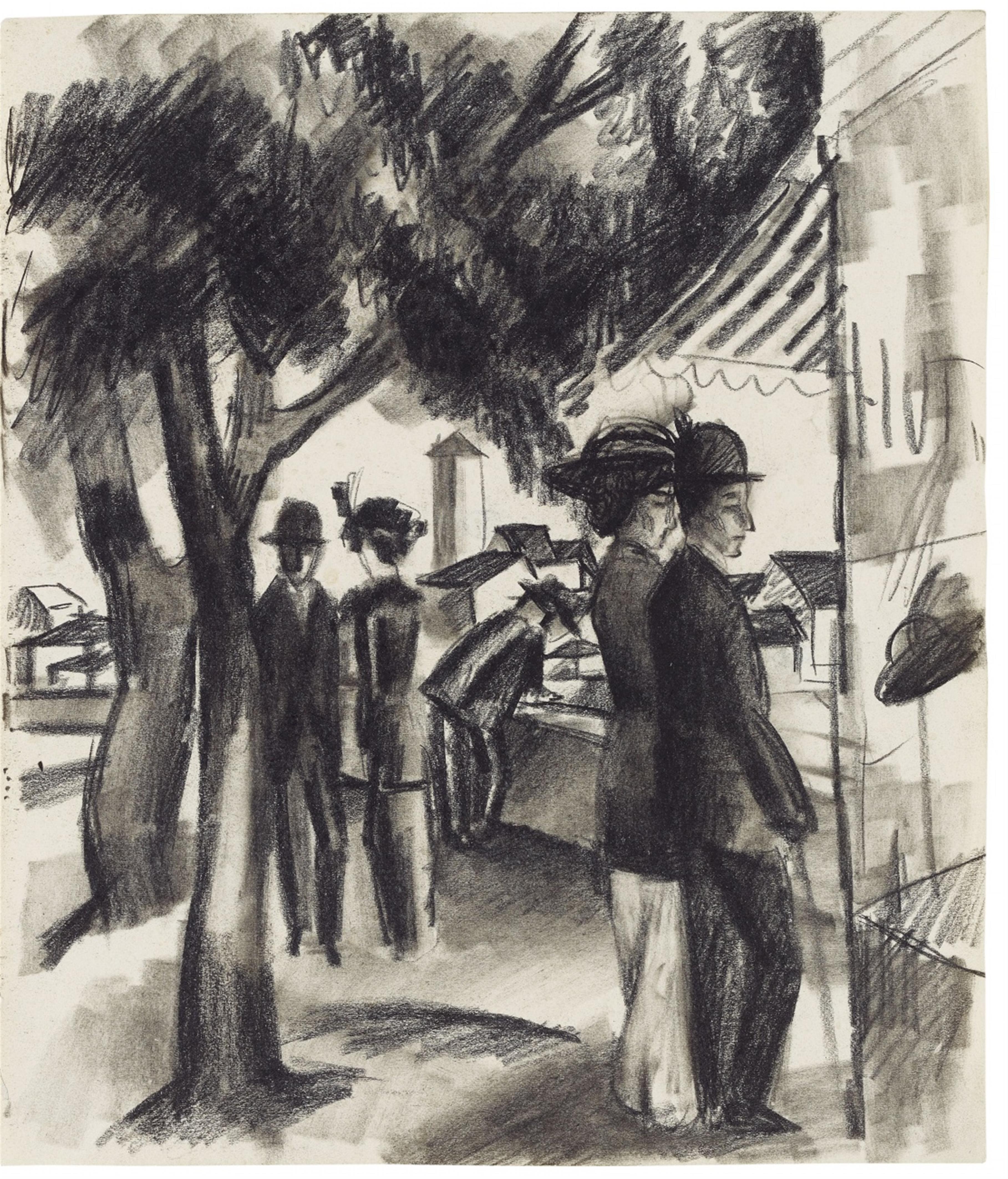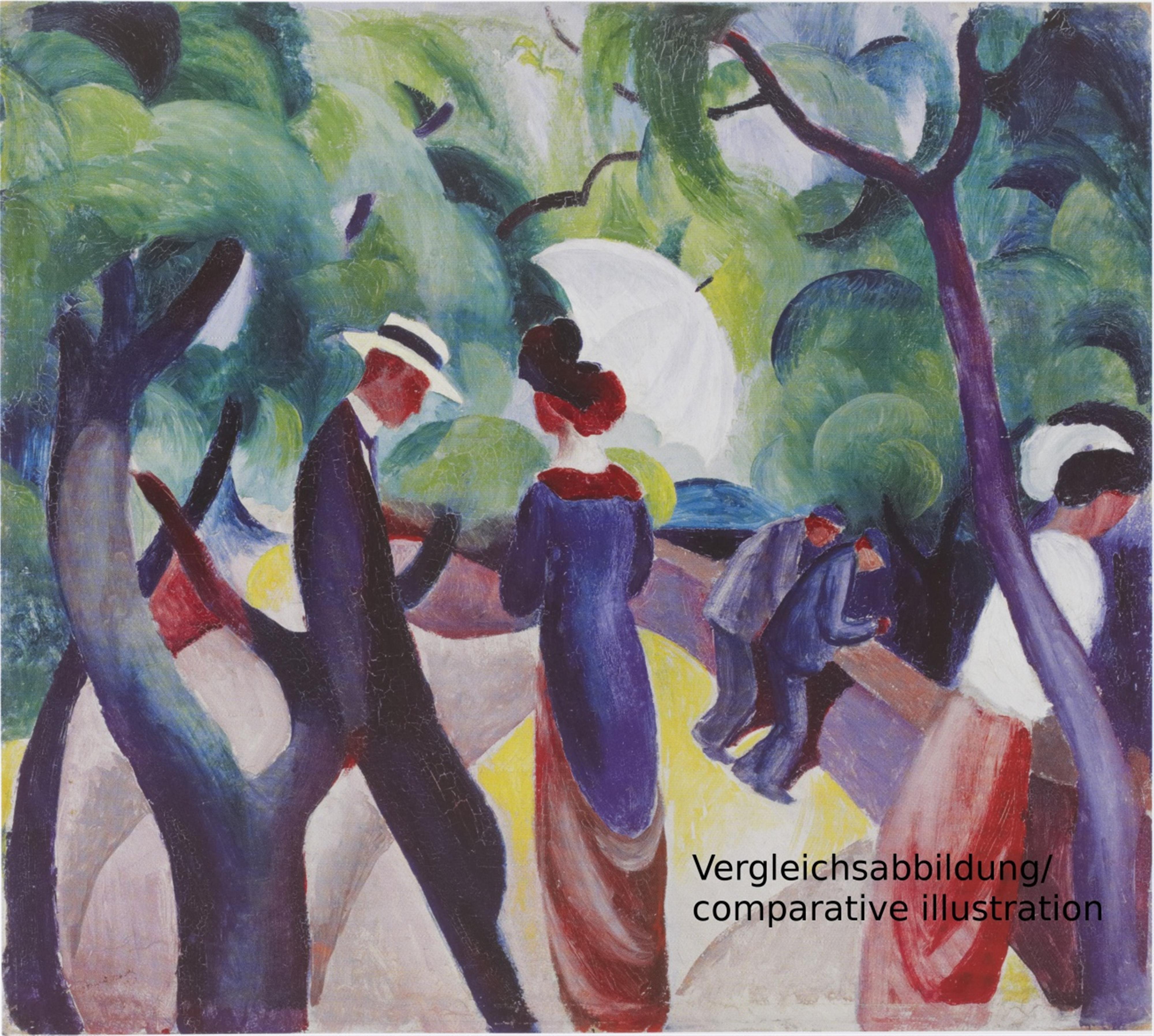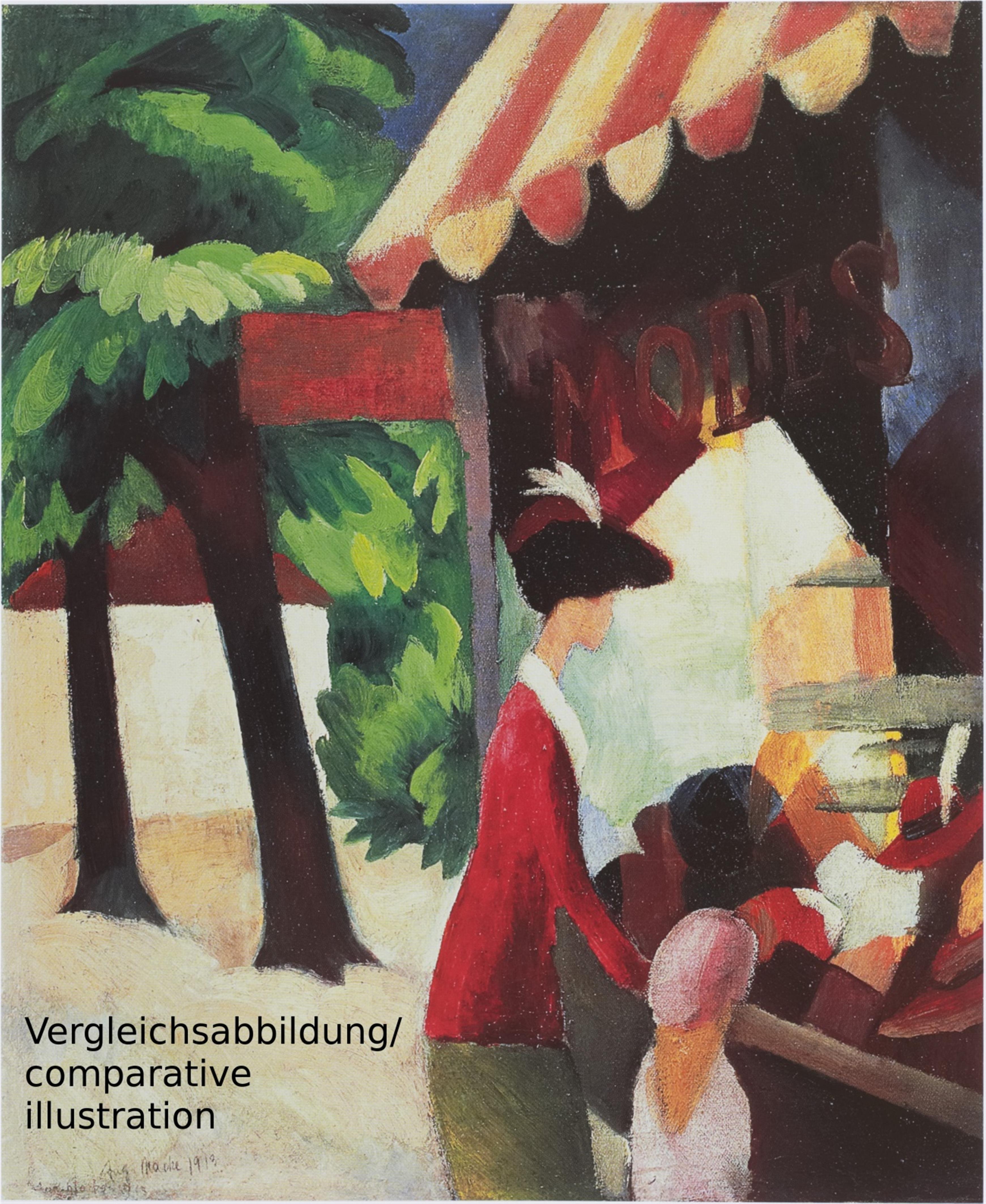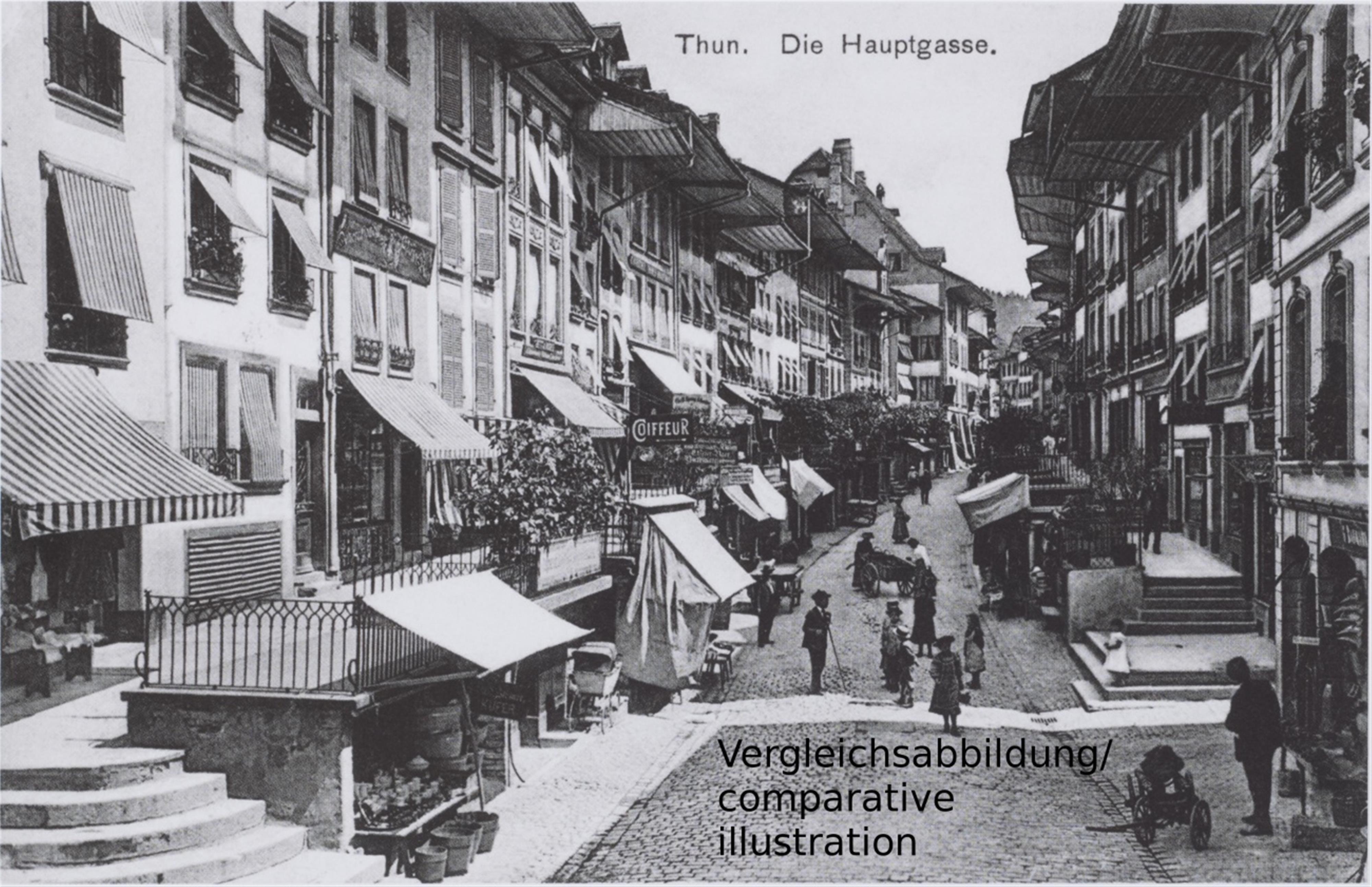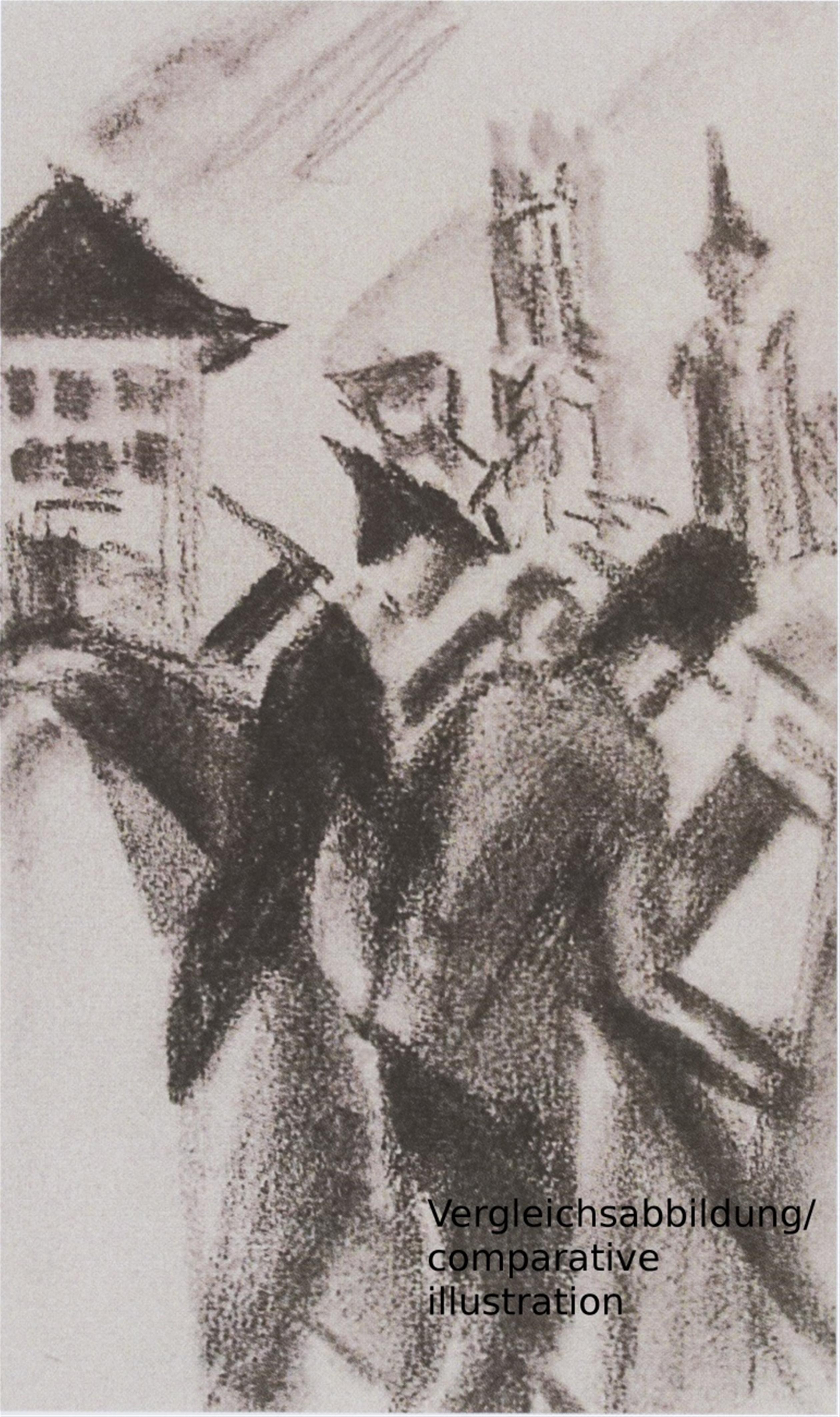August Macke
Spaziergänger unter Bäumen
1914
Black crayon drawing, partly wiped, on firm, smooth chamois-coloured drawing paper 34.3/34.5 x 29.5/29.8 cm Unsigned. - Verso with the oval estate stamp "Nachlass AUGUST MACKE" (twice) at the bottom; left additionally inscribed "Spaziergänger unter Bäumen, / rechts Hutladen hinten Stadt/ KZ 3,4" in pencil by an unknown hand and dated within the stamp "1912". - The sheet slightly irregular in the left margin. Verso in places with traces of India ink (studio traces). - In fine condition.
The oft-exhibited chalk drawing “Spaziergänger unter Bäumen” by August Macke is among the most outstanding sheets of his late graphic work. Not only does it combine various different individual motifs that are very well-known and characteristic for Macke, in its clear spatial construction and graphic style it displays a quality - as a sheet in black and white - that is equal to that of the paintings or watercolours. Comparable late drawings by Macke have been considered to be distinguished through a final “simplification of means”, which leads to an “expansively conceived painting-like effect” (Paul Vogt, Zum zeichnerischen Werk von Franz Marc und August Macke, in: exhib. cat. Pels-Leusden, Berlin 1977/1978, op. cit., p. 6). According to information provided by the editor of the catalogue raisonné, Ursula Heiderich, although “1912” was entered with the estate stamp, the sheet - based on its “motivic content, technique and style” - indubitably belongs to the Hilterfingen Period, which produced an extraordinary concentration of works in 1913/1914 and represents a particular highlight in his oeuvre, directly before the famous journey to Tunis in the summer of 1914.
As though quoting his own work, the mentioned motivic repertoire of the drawing encompasses the elegant urban couple and the shopwindow motif with reflective panes of glass and the hat display including its “Thun” marquee as well as figures strolling under the trees and leaning over a railing or parapet, calmly occupied with their view of and into an undefined distance. The suggested terrace complex of the composition recalls real topographies on the one hand - Fribourg for example (cf. “Kathedrale zu Freiburg in der Schweiz”; 1914; Heiderich 548) - on the other hand, the pair of men looking out from the parapet are connected with Macke's last painting, the “Abschied” of the Haubrich collection, an unfinished figural composition in which two large figures, who lean over and are seen from behind while they face to the right and are fragmented by the edge of the painting, provide the foreground with formal as well as highly symbolic weight (cf. Heiderich 590).
The spatial disposition of the “Spaziergänger unter Bäumen” is remarkable: in this drawing the pairs of figures, arranged in a triad-like series of layers, are placed at the levels of the foreground, middle ground and background. At the same time, clear gaps between the figures have been formed and views leading through the open space have been arranged. The composition is additionally articulated and framed through the emphasised verticals that meet with a horizontally oriented counterweight in the simplified architectonic contours of the city depicted in the background. “The shopwindow not only functions as an introduction into the image, it also provides the spatial continuum, which runs from the front right to the back left, with a transparent beginning [...]” writes Dierk Stemmler, who also feels that Macke has organised the space “not only perspectivally” but also “figurally lively” (cited in exhib. cat. Bonn 1979, op. cit., p. 268) and imparted it with a transparency as well as lightness, which are achieved not least through graphic stylistic devices like the light hatching in the reflective display windows - which seem entirely abstract - or through the feathery use of line in the dense crowns of the trees.
The artistic form and the atmosphere simultaneously elevate the image from the level of the concrete to that of the timeless and universal. “The sheet preserves a high intrinsic value of graphic beauty and encompasses a range of highly diverse nuances in its drawing, which render its subject calm. The figures, which seem to hover in their static dependency, arouse the impression that they seem to have been realised entirely in a state of being that is no longer of this world, as though they found themselves in a realm of their pure togetherness, increasingly illuminated by light” (Carl Bäufer, August Macke als Zeichner, in: exhib. cat. Münster 1957, op. cit. p. 46).
Catalogue Raisonné
Heiderich 2419 (estate list KZ 3/4)
Certificate
We would like to thank Ursula Heiderich, Syke, for kind information.
Provenance
From the artist's estate; Private possession
Literature
Carl Bäufer, August Macke als Zeichner, in: exhib. cat. Münster 1957, p. 45 f.; Günter Busch, August Macke - Handzeichnungen, Mainz/Berlin 1966, cat. no. 46 with illus.; Frank Günter Zehnder, Ein neu entdecktes Portrait von der Hand August Mackes - zur Deutung von Mackes 'Abschied' im Museum Ludwig, in: Kölner Museums-Bulletin 1/1991, p. 11 with illus.; Dierk Stemmler, August Macke, in: exhib. cat. Die Rheinischen Expressionisten, August Macke und seine Malerfreunde, 1979, p. 268; Ina Ewers-Schultz, August Macke, Maler des modernen Lebens, in: exhib. cat. August Macke und die Schweiz, 2013/2014, cf. p. 56 ff.
Exhibitions
Münster 1957 (Westfälisches Landesmuseum für Kunst und Kulturgeschichte), August Macke - Gedenkausstellung zum 70. Geburtstag, cat. no. 157 with illus. p. 74 and detail illus. on the catalogue cover; Bonn 1957 (Städtische Kunstsammlungen), August Macke als Zeichner, cat. no. 37; Reutlingen 1958 (Hans-Thoma-Gesellschaft e.V., Spendhaus), August Macke, cat. no. 28; Bremen 1964/1965 (Kunsthalle Bremen), August Macke, Handzeichnungen und Aquarelle, cat. no. 85 with illus. p. 44; Gießen 1970 (Bürgerhaus Gießen), Rheinische Expressionisten: August Macke, Helmuth Macke, Paul Adolf Seehaus, Hans Thuar, cat. no. 18; Münster/ Bonn/ Krefeld 1976/1977 (Westf. Landesmuseum für Kunst u. Kulturgeschichte/ Städtisches Kunstmuseum Bonn/ Kaiser-Wilhelm-Museum Krefeld), August Macke 1887-1914, Aquarelle und Zeichnungen, cat. no. 122 with illus. p. 150; Berlin 1977/1978 (Galerie Pels-Leusden), Franz Marc - Gouachen, Aquarelle und Zeichnungen, August Macke - Gemälde, Pastelle, Aquarelle, Zeichnungen, Plastik, cat. no. 89 a (loan); Bonn/ Krefeld/ Wuppertal 1979 (Städtisches Kunstmuseum Bonn/ Kaiser-Wilhelm-Museum Krefeld/ Von der Heydt-Museum), Die Rheinischen Expressionisten, August Macke und seine Malerfreunde, cat. no. 253 with illus. p. 255; Bonn 1981 (Bundeskanzleramt), August Macke, cat. no. 46 with illus.; Münster/ Bonn/ Munich 1986/ 1987 (Westf. Landesmuseum für Kunst u. Kulturgeschichte/ Städtisches Kunstmuseum Bonn/ Städtische Galerie im Lenbachhaus), August Macke, Gemälde, Aquarelle, Zeichnungen, cat. no. 333 with illus. p. 409; Thun/ Bonn 2013/ 2014 (Kunstmuseum Thun/ August Macke Haus Bonn), August Macke und die Schweiz, cat. no. 66 with illus. p. 82; Bonn/ Munich 1914/ 1915 (Kunstmuseum Bonn/ Städtische Galerie im Lenbachhaus und Kunstbau München), August Macke, Franz Marc, Eine Künstlerfreundschaft, cat. no. 169 with illus. p. 272; long-term permanent loan from private possession at the Kunstmuseum Bonn (until 2015)

